The first stop in the revised program was a visit to Ekasup Cultural village, where islanders dressed in traditional costumes entertained us in a clearing with demonstrations of traditional skills, magic illusions and dancing.
We were welcomed by a conch shell blowing young man who was apparently one of the sons of a village chief.
|
 |
|
The same warrior chap demonstrates how long before mobile phones were around, islanders would communicate with each other by leaving drawings in sand on their doorsteps to tell family or neighbours where they were, for example, a drawing of a fish would signify the house dwellers were out fishing!
|
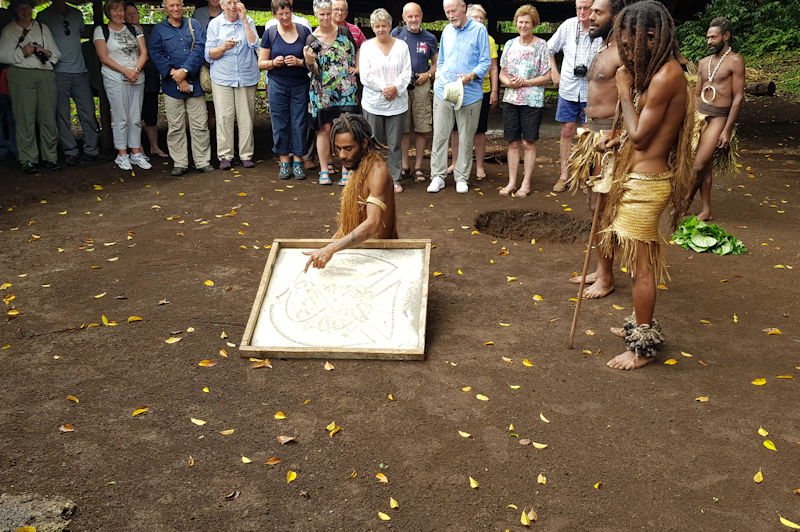 |
|
Another man creates fire by rubbing a stick on a small log with a groove. This has been done before by Bear Grylls, but believe me, this guy got a spark lit in around a minute, he was that good. Who needs matches in this palce?
|
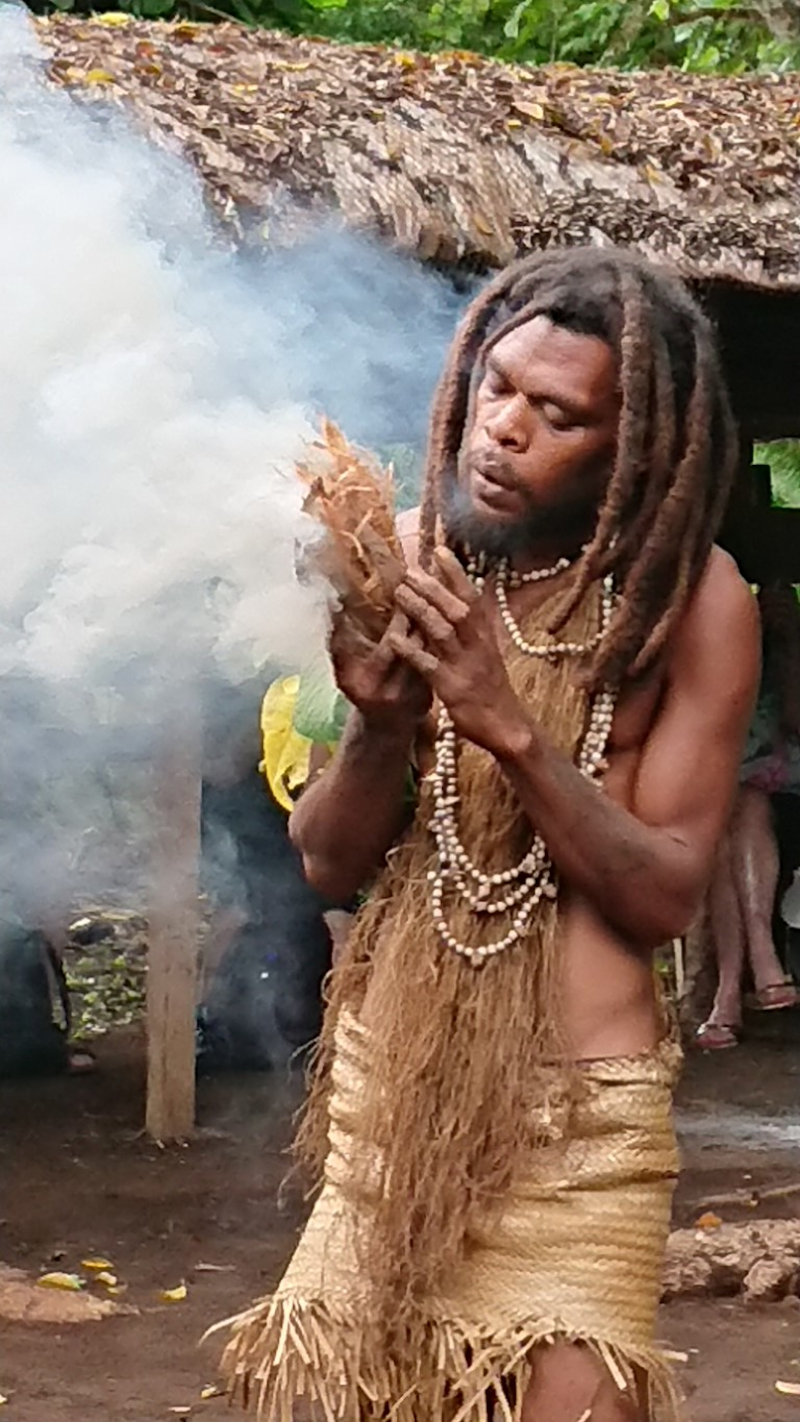 |
|
I am invited to check that a coconut is indeed whole, not tampered with and intact, before one of the guys places it on the ground, punches it and breaks it open. Ouch!
|
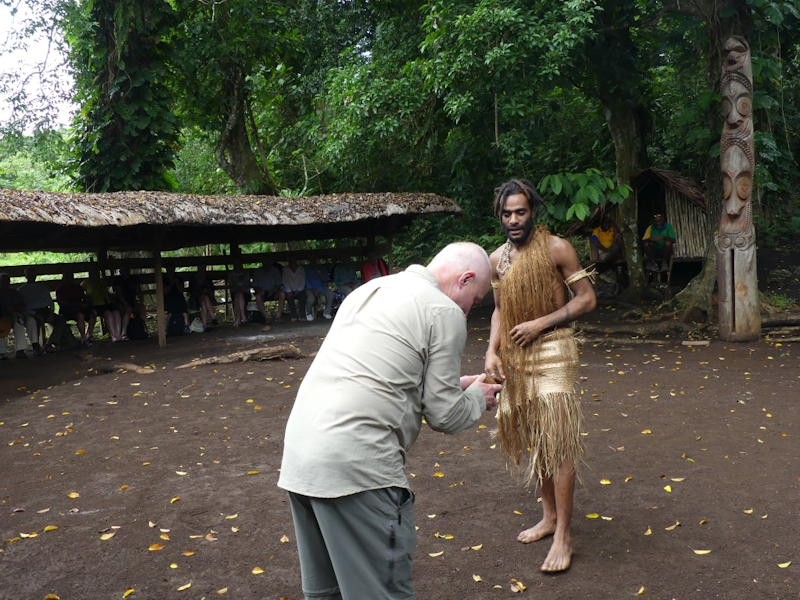 |
Our second excursion in the morning takes us to the Mele Cascades, a series of waterfalls in the jungle with a pool to swim in.
In this shot, the local guide demonstrates how water is repelled on the surface of a particular leaf into droplets, like blobs of mercury.
|
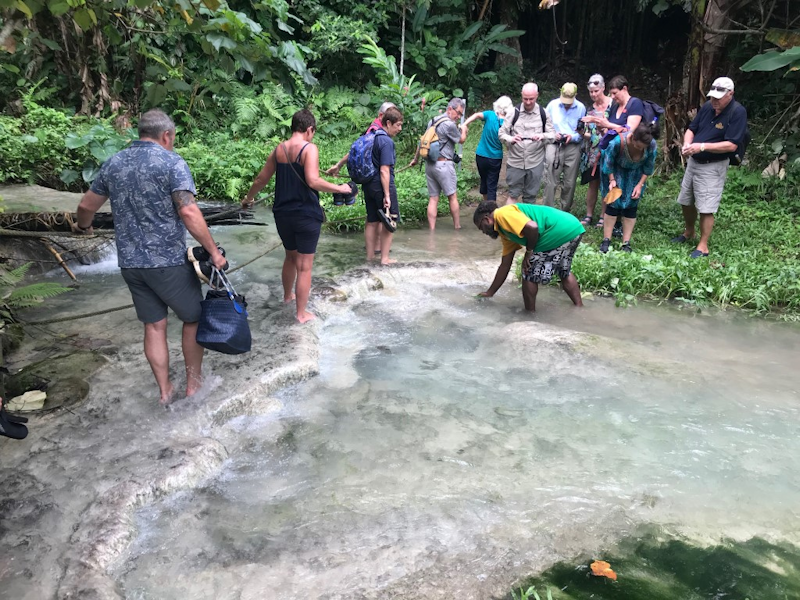 |
|
Heading further along the stream, the guide talks about local plants and how they are used, here a large clump of growing bamboo.
|
 |
|
Some of the lower steps of cascading water as we climb the path going further up the stream.
|
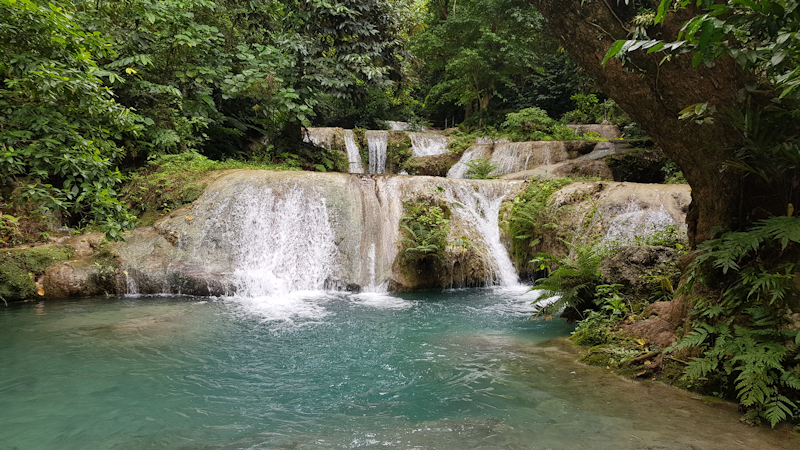 |
|
Another view demonstrates the beauty of this popular location, about 6 miles from Port Vila.
|
 |
|
A number of us, including myself doing an aeroplane impression, heading up to the natural pool where swimming and jumping in was possible.
|
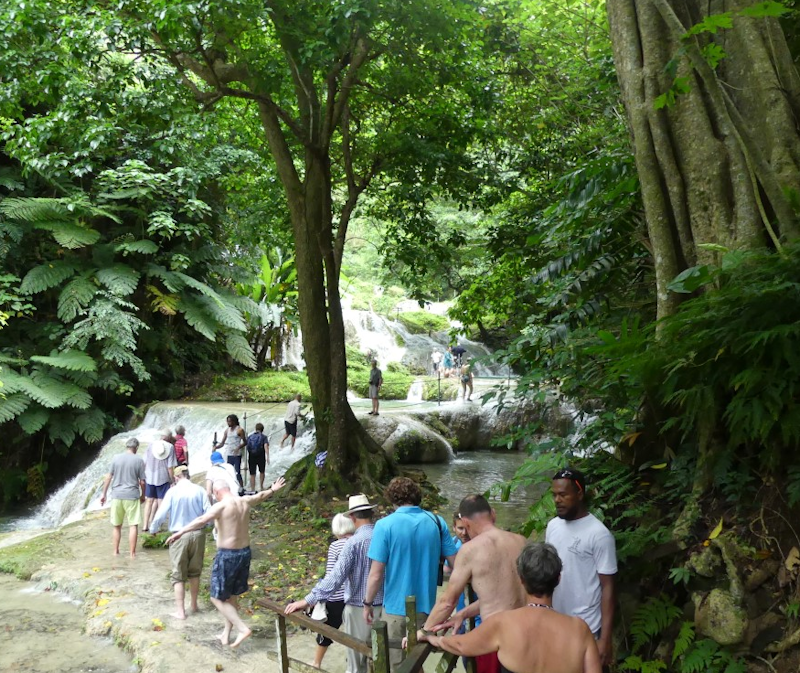 |
|
At least ten of us share the fun of outdoor swimming in a tropical pool.
|
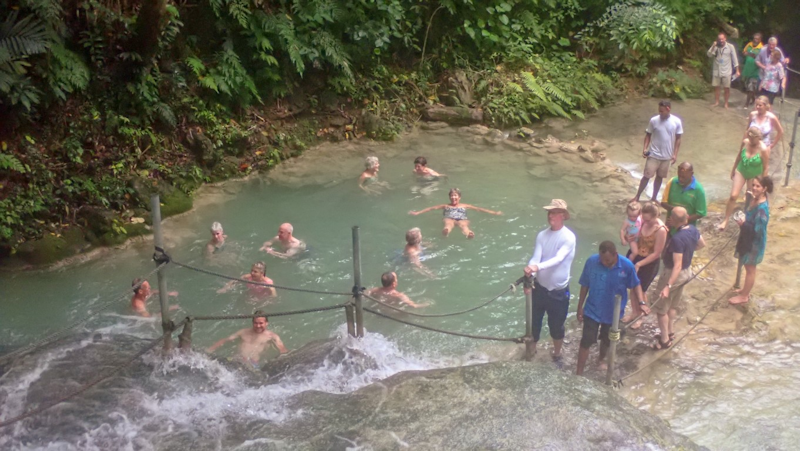 |
|
Returning to the seating area for refreshments of fruit and juice.
|
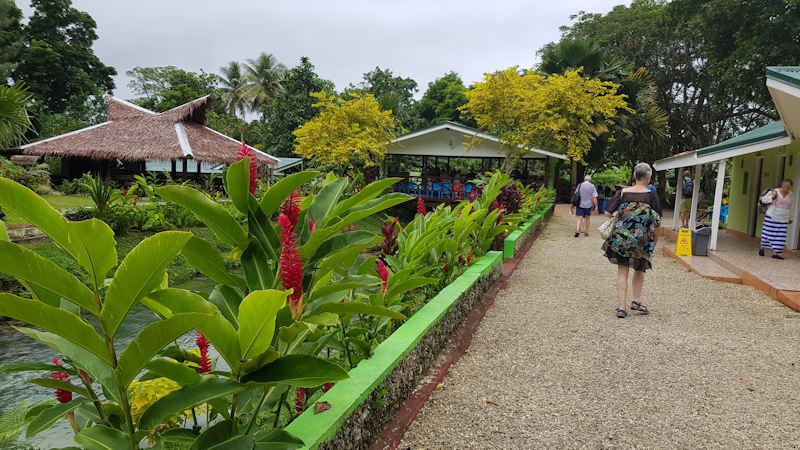 |
|
In the afternoon there was transport laid on for those who wanted to visit the town of Port Vila. I didn't choose to go, but here is a photo taken in town.
|
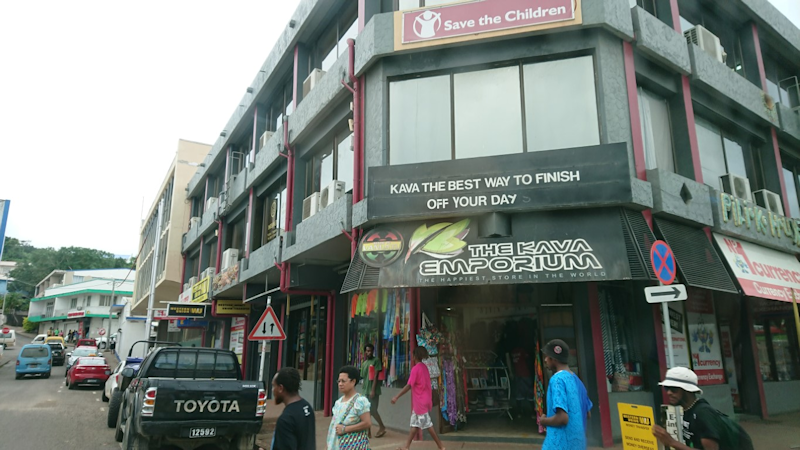 |
|
Some colourful flowers on sale at the market.
|
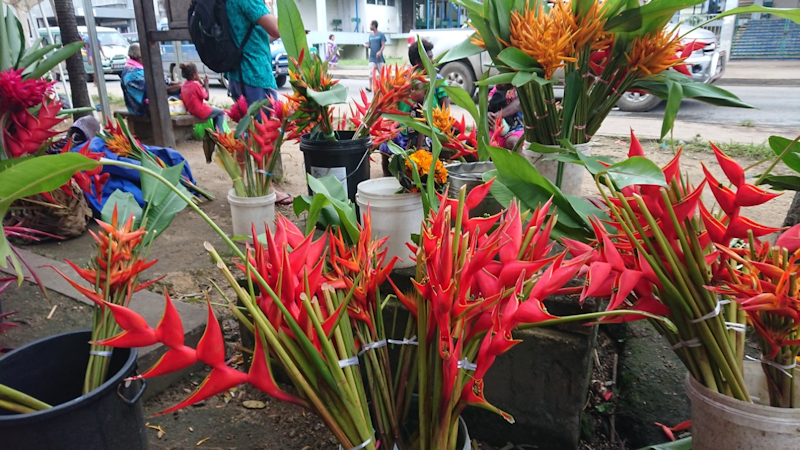 |
The 'Island Sky' berthed at Port Vila's wharf during the day.
Because of the enforced change of plans, tomorrow's voyage clockwise around the island would be relatively short.
|
 |
On Saturday 11th May the ship stopped close to Lelepa Island, close to the main island of Efate.
The Feles cave, part of a UNESCO World Heritage Site, forms part of Chief Roi Mata's Domain. The latter was a an influential chief who lived in the 1600's in the area.
The inner walls of the circular cave are covered with cave paintings, some dating from the first millenium.
After arriving at the beach with a welcome, parties of us were taken to and within this cave by local guides, before we returned and explored the local village.
|
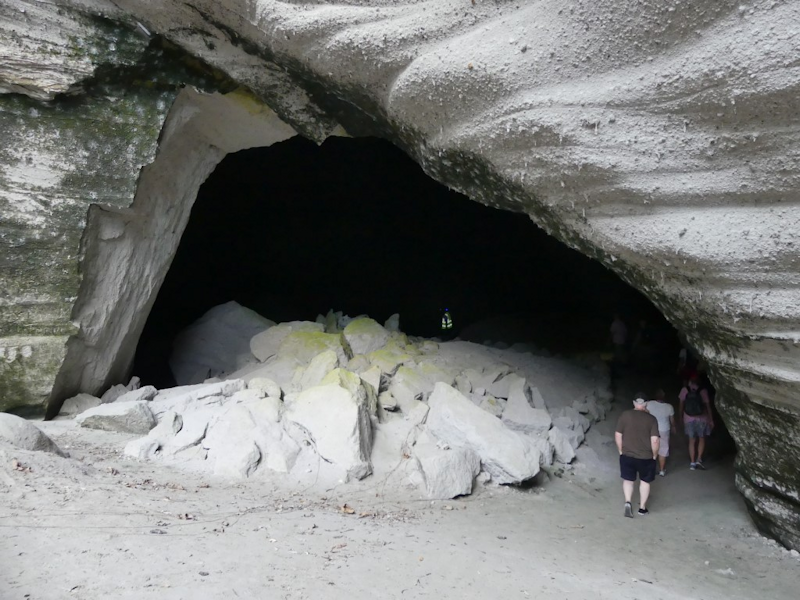 |
|
We head towards Lelepa Island with the ship behind us and the sunhat shaped Artok island in the distance.
|
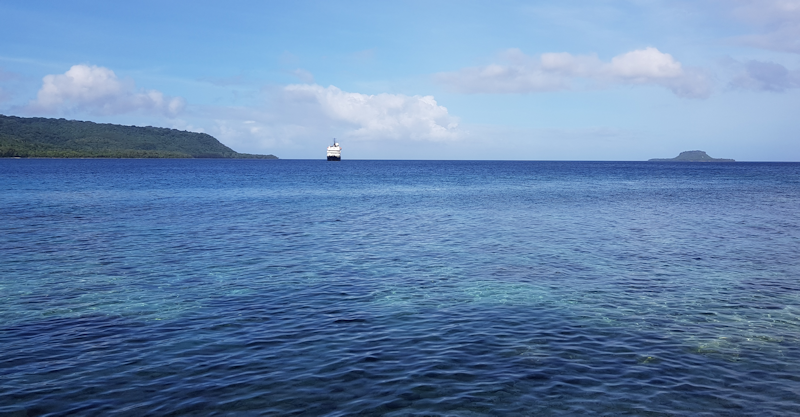 |
|
Arriving on the coral beach, where some local women had set up stalls on the coral beach selling baskets and handicrafts as their children played nearby.
|
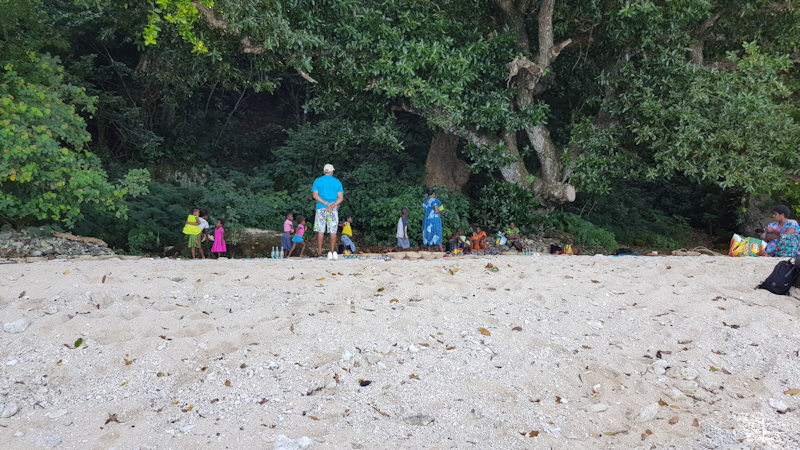 |
|
More fellow passengers arrive at the beach in a zodiac.
|
 |
|
Local villagers warmly welcome us with singing and music.
|
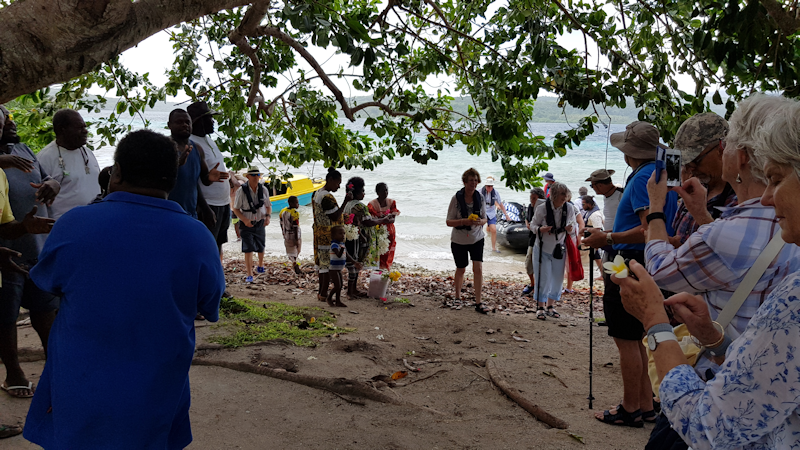 |
|
The village was clean and well maintained, with gardens and flowers amongst the buildings.
|
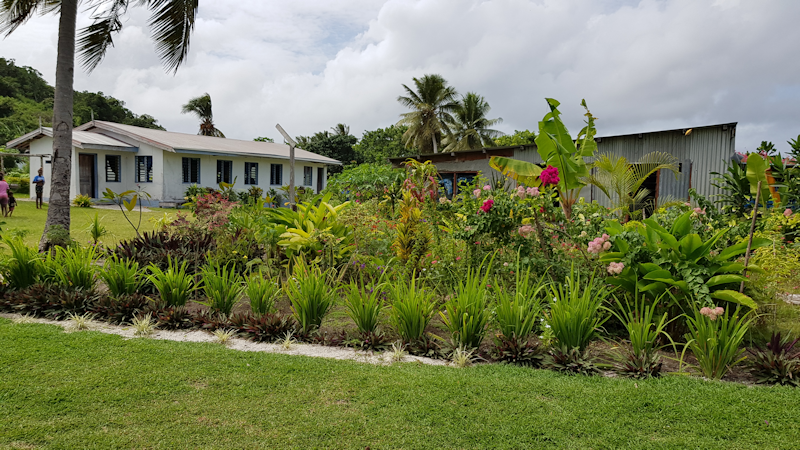 |
|
The local shop was closed on this occasion.
|
 |
|
Everyone was provided with coconuts full of refreshing 'milk', here being prepared by Chris, one of the immigration officials who accompanied us while the ship was in Vanuatu waters.
|
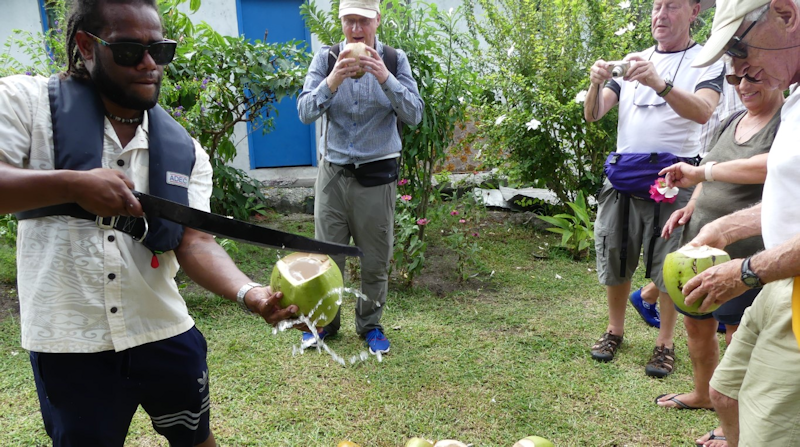 |
|
A sign on this coconut tree in the local Pidgin English says, in effect, that it is forbidden to cut (down) any of the trees in this area.
|
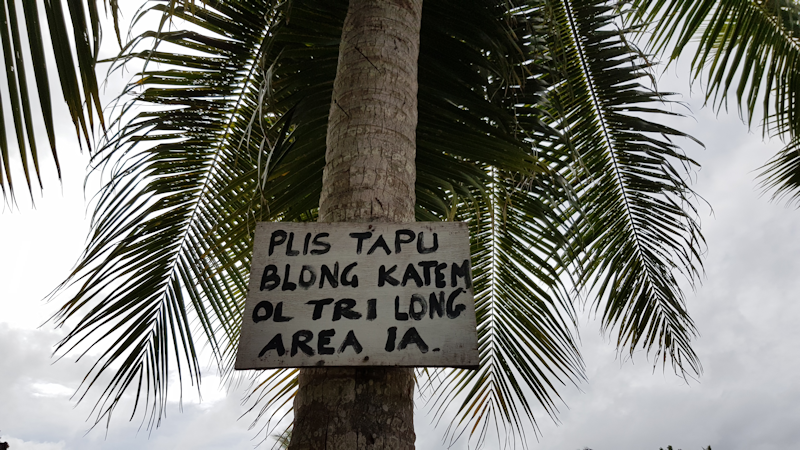 |
|
The rainwater storage tank in the village, which is called Tassiriki.
|
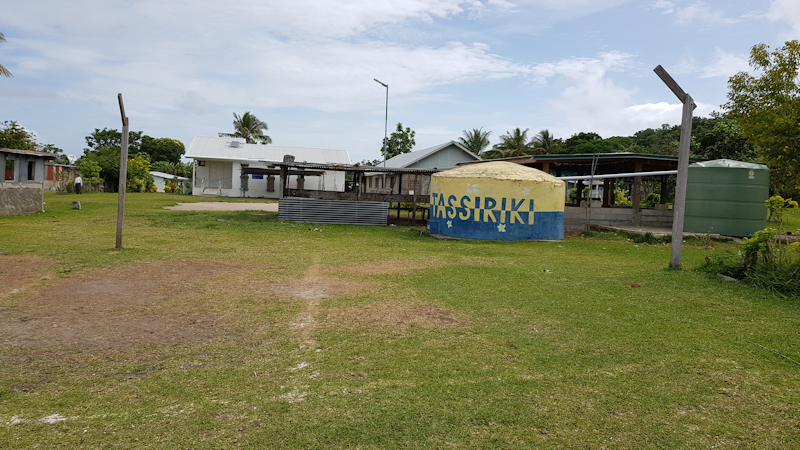 |
After returning to the ship and having lunch, the afternoon saw the ship move a few miles into Havannah Harbour, between Moso Island and Efate.
The program was to visit the Tranquility Dive and Eco Resort just behind the shore to see young Hawksbill turtles being raised, a few of them being released into the sea each week.
After the turtles there was the opportunity to swim off the beach.
|
 |
|
A shower in the afternoon conveniently provided a rainbow which seemed to cling onto the bow of the ship.
|
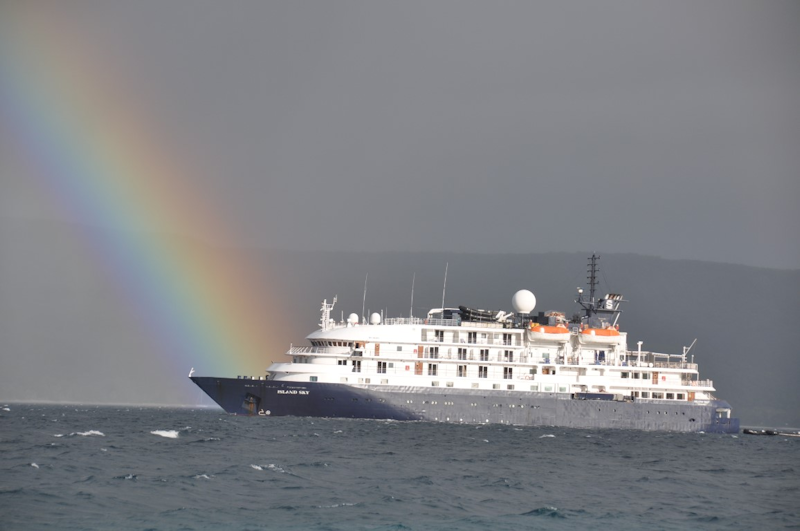 |
Here I watch the turtles swimming around several large circular tanks in the Eco Resort.
With Hawksbill turtle numbers being under threat, this enterprise claims that it can help to mitigate this decline by rasing turtles safely on land before releasing them in small numbers at a size when they are less likely to be predated by sharks.
|
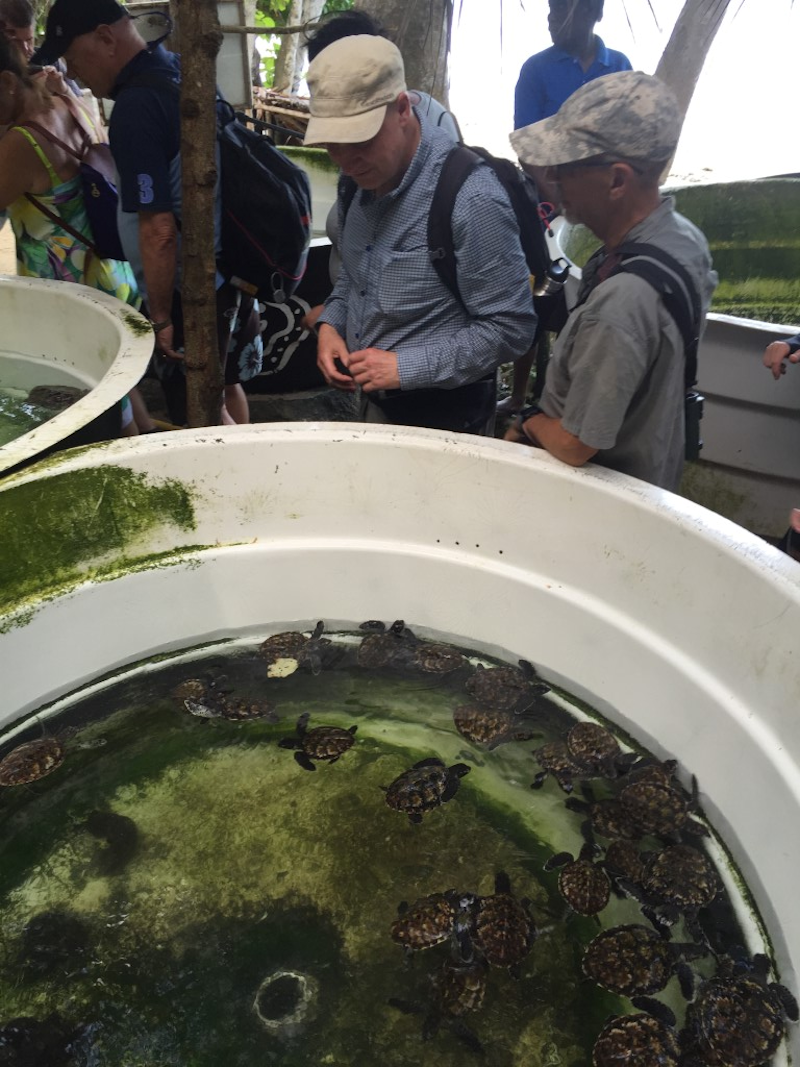 |
Later I swam in the sea, just off the beach, chatting to other passengers while avoiding rocky clumps of coral just below the surface.
Such a hazard to health was soon to cast a shadow over my enjoyment of the Pacific seas!
|
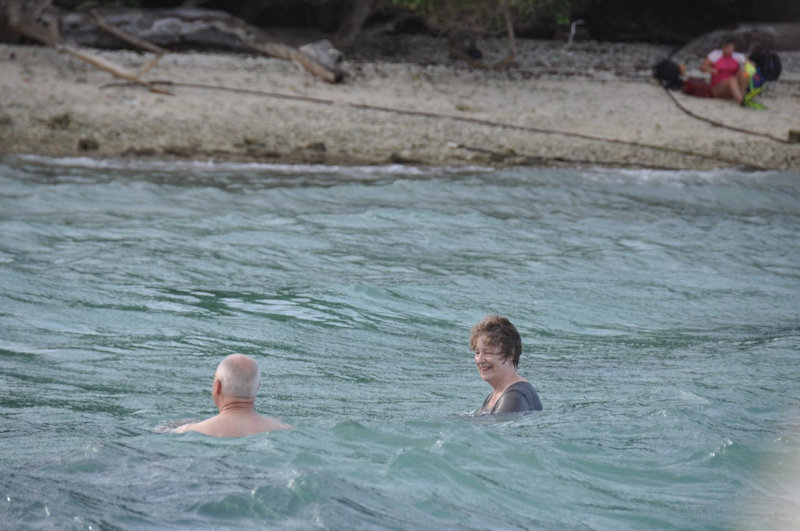 |
Our third day in Vanuatu, Sunday 12th May was to Pentecost Island, about 60 miles southeast of the large Espiritu Santo island.
Pentecost is well known as the place where land divers jump head first from towers up to 80 feet tall made from bush timber, with vines around their ankles.
Effectively, this is where bungee jumping really started!
The practice, locally called Nanggol, is a fertility ritual aimed at ensuring a good yam harvest.
Here we have arrived on shore at the village of Londot
|
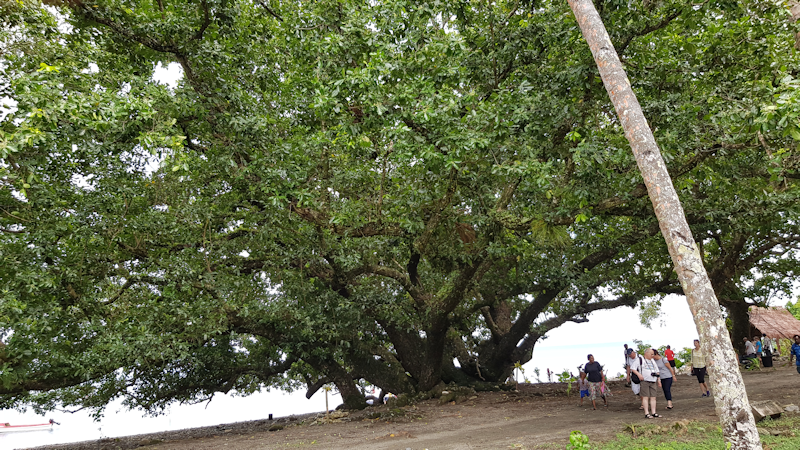 |
|
We are met by some of the villagers.
|
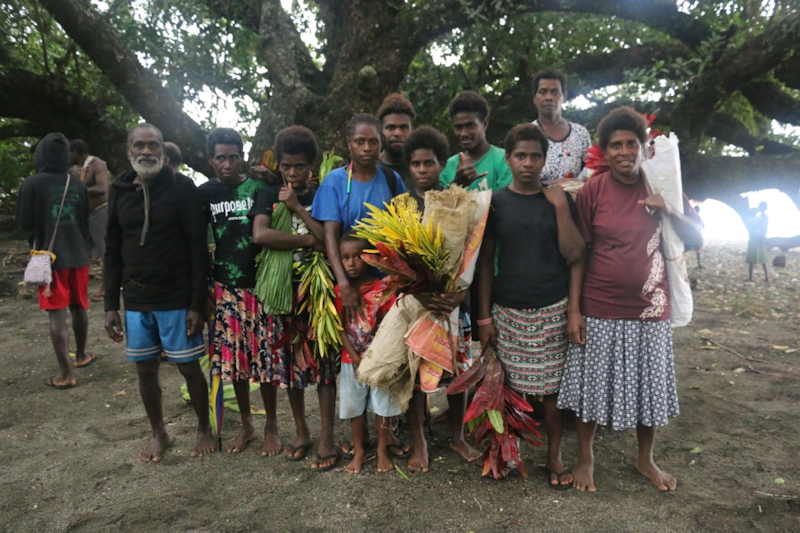 |
|
There was, of course, singing and music. |
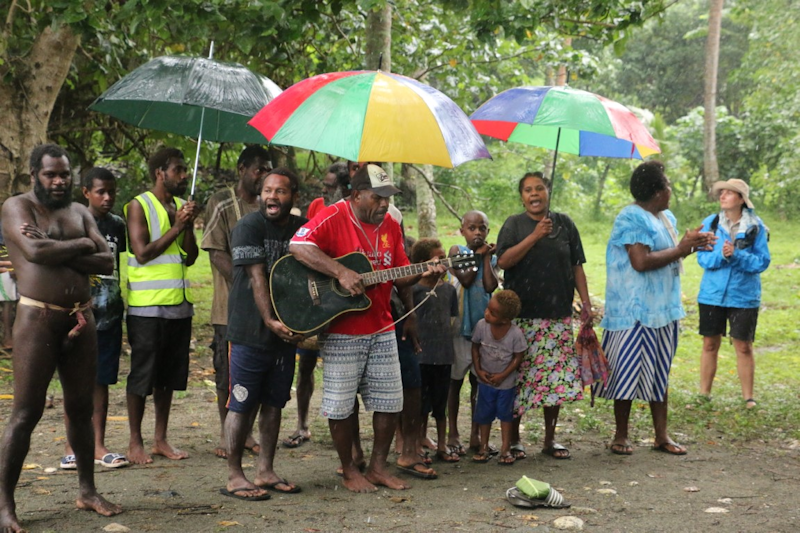 |
|
A little later in the morning, our group was led up a hill to the area below the tower where there were benches and peripheral points to watch the spectacle. |
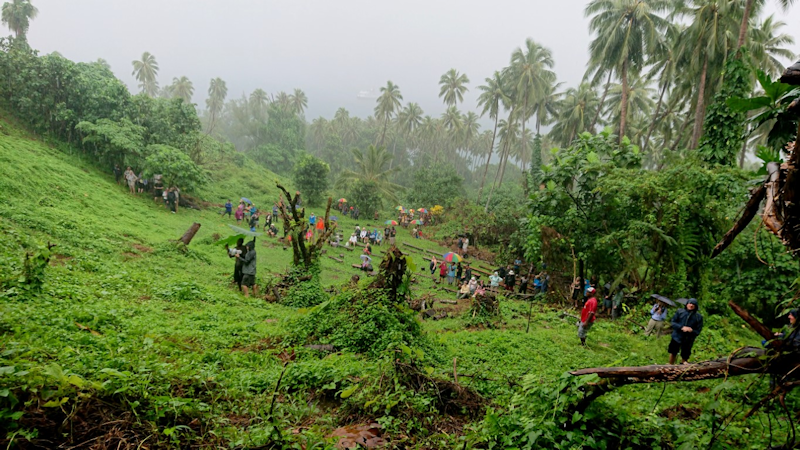 |
|
You can tell by this photo that it wasn't the best of weather for the spectators, though I'm sure the muddy ground would help the divers, who ended up on the slope just below the tower.
|
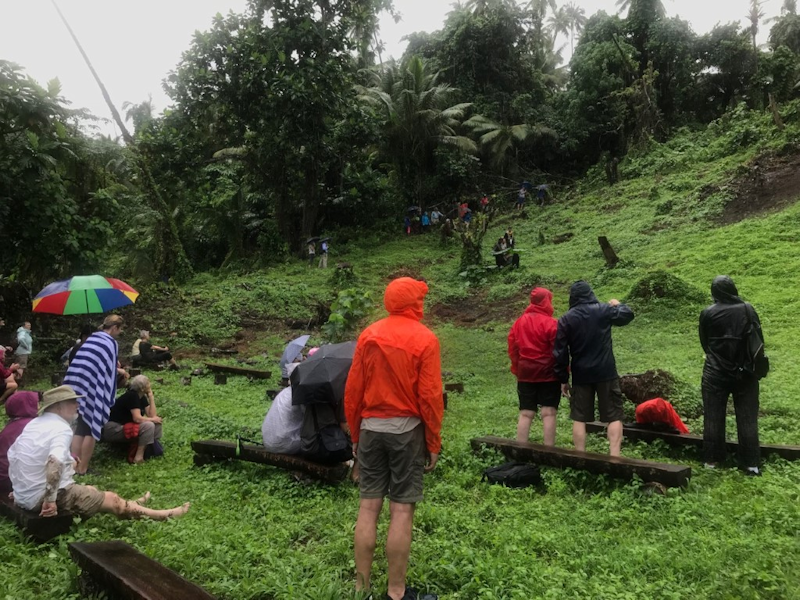 |
There were seven dives, starting lower on the tower and ending up right at the top.
The final diver was a sort of champion, who did both of the final two dives.Here he is just beginning his penultimate dive from a platform below the top.
|
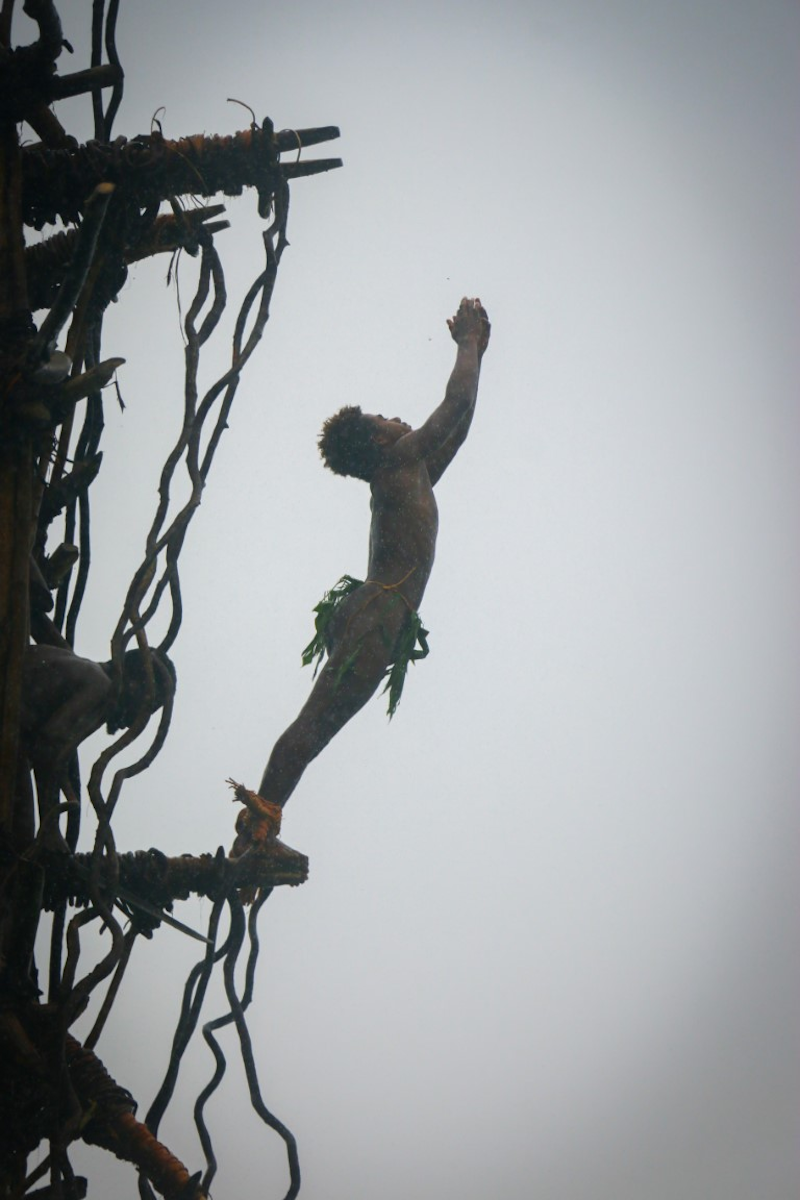 |
Well here's the finale.
Right from the topmost platform, the champion performer, with chanting and shouting from the group of men behind the tower, gets to his pivot position.
|
 |
|
I've combined three shots into one image here as the champion begins his leap.
|
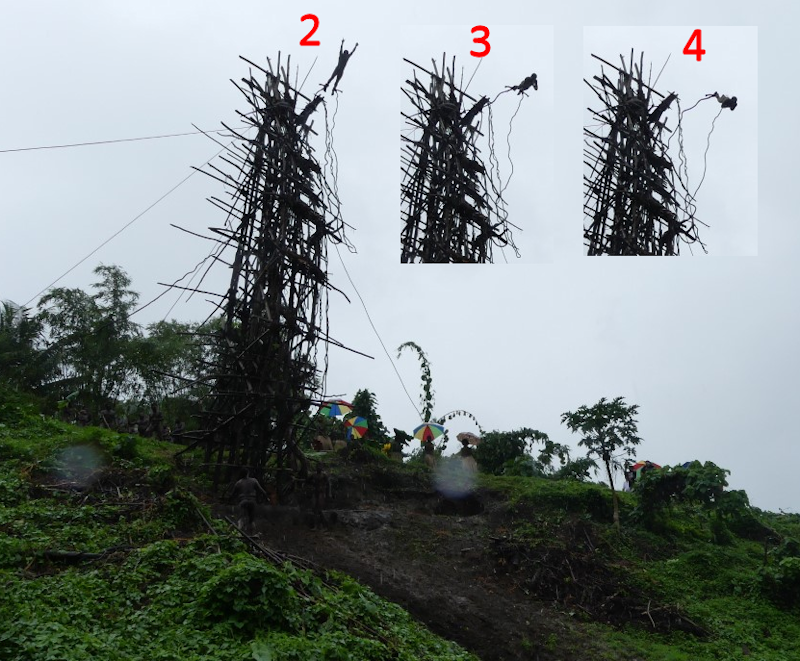 |
At the end of his dive he makes light contact with the muddy ground.
The vines are carefully pre-measured to ensure he is not in danger of hitting the ground in such a way as to cause injury.
|
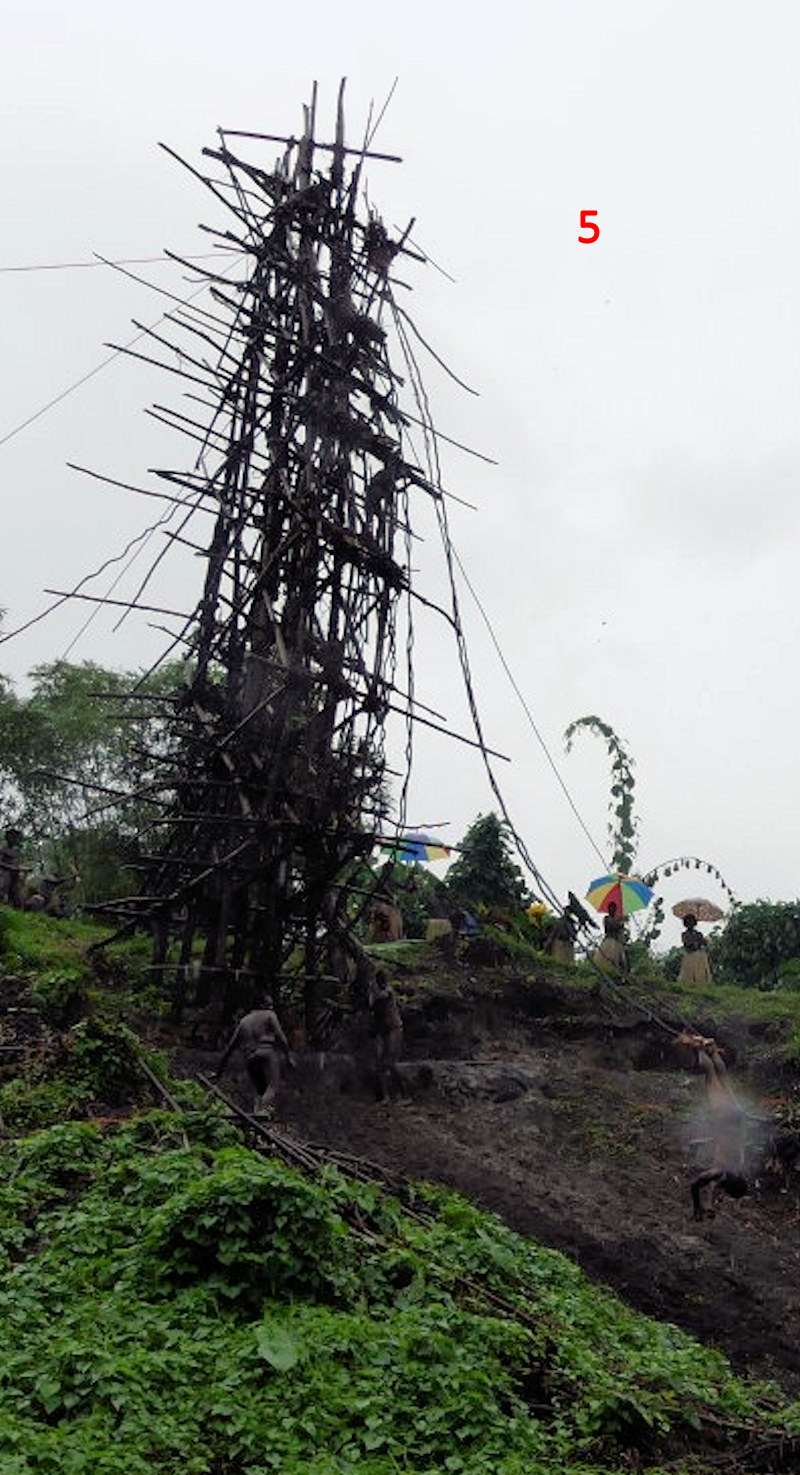 |
|
Success for the champion, who is helped out of his vines by two men below the tower and clambers back up the landing slope.
|
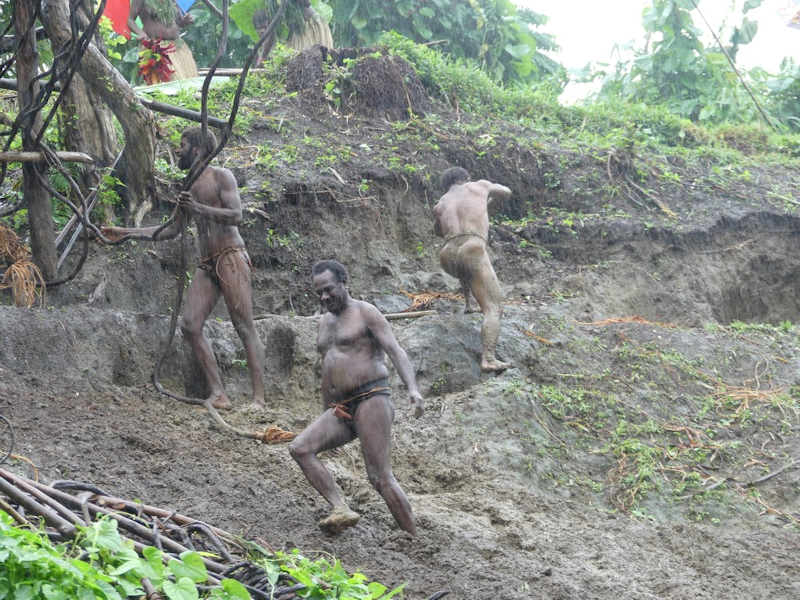 |
|
Our time at the village is coming to an end and there is more music and a little dancing by some of the guests (including me, actually)!
|
 |
|
This huge spreading tree dominates the sea shore and no doubt is an important feature for the local village.
|
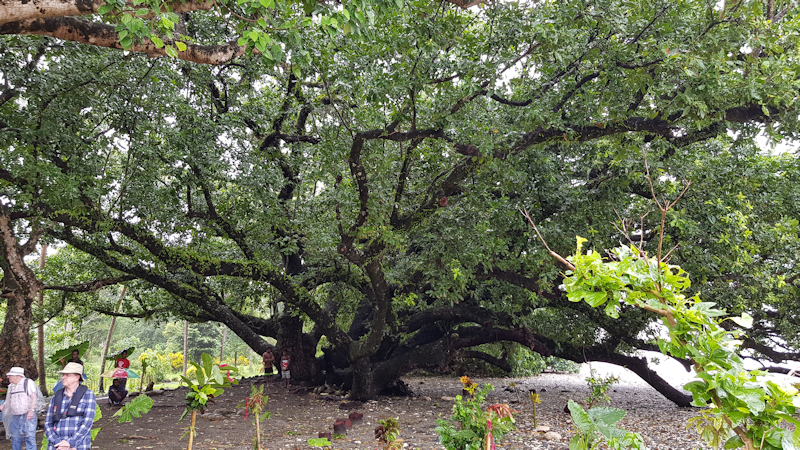 |
Zodiacs begin taking the passengers off the island and back to the ship for lunch.
There was a further opportunity for swimmers and snorkellers to return to the shore after lunch.
|
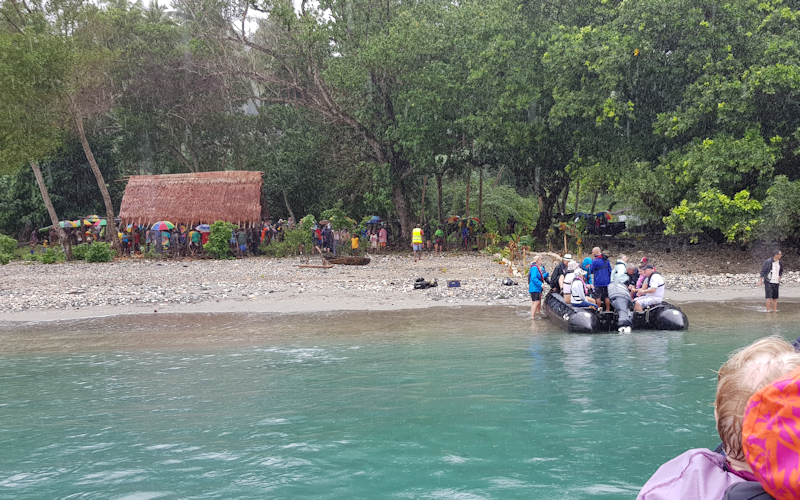 |
|
Although I didn't take part in the afternoon swim, here is a fantastic picture of some of the coral formations in the shallows away from the beach.
|
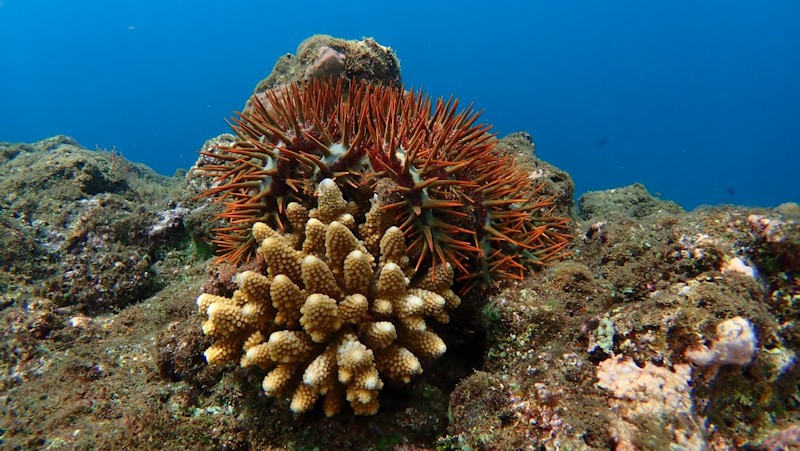 |
One of the snorkellers.
The colours in the sea provided some lovely underwater photographs taken on behalf of the guests by expedition crew members.
|
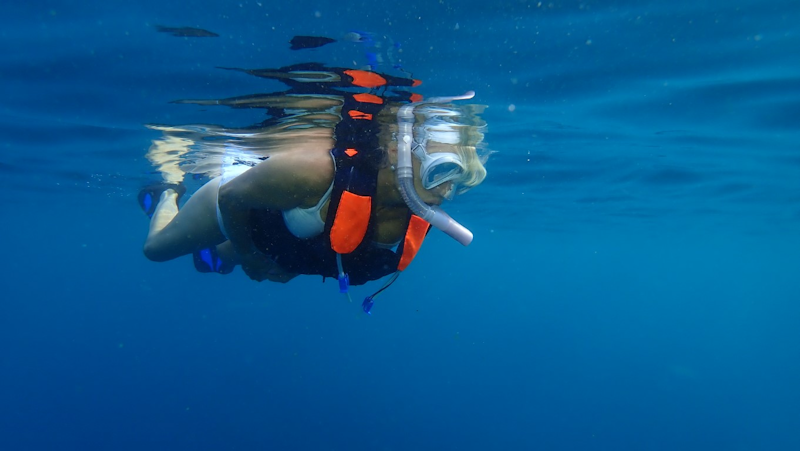 |
Monday 13th May. Luganville town, Espiritu Santo island.
Today was a 'dry feet' day as the ship berthed at the main wharf of this town of 15,000 inhabitants, the second biggest town in Vanuatu.
When Kym and I used to fly to Honiara in the 1970s, the Fiji Airways/Air Pacific aircraft used to land at the nearby airport here before the final leg of the long journey to Honiara.
|
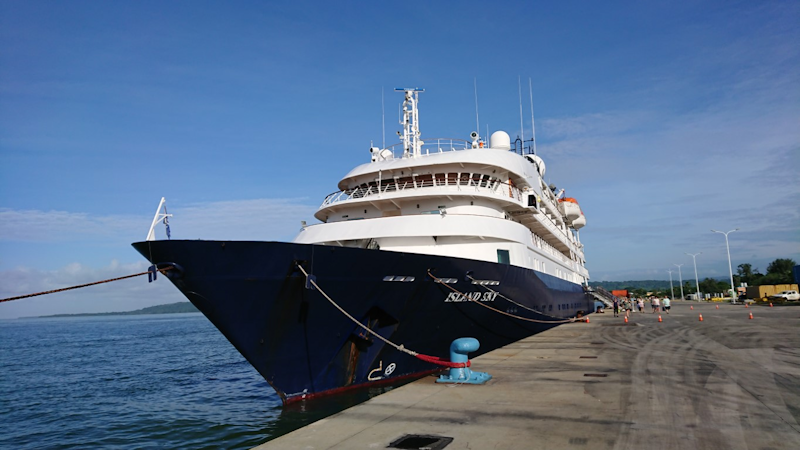 |
The first activity in the day's program was a visit to the Leweton Cultural Experience, a short ride north of the town.
|
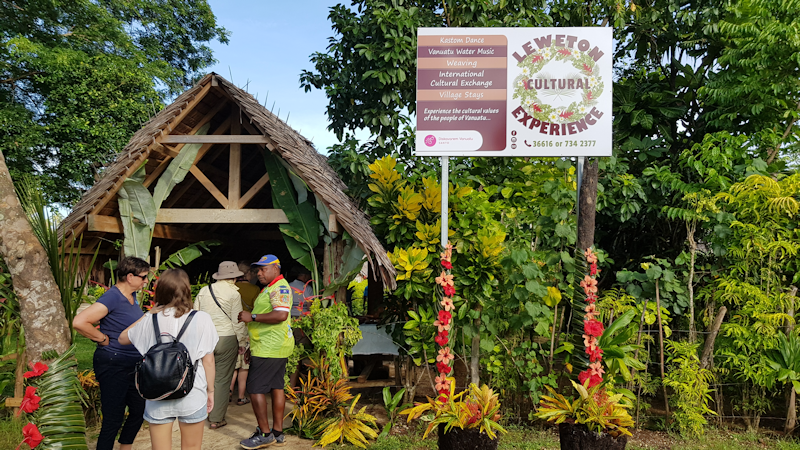 |
The cultural village was neat and attractive, with many flowers such as these hibiscus around the grounds.
|
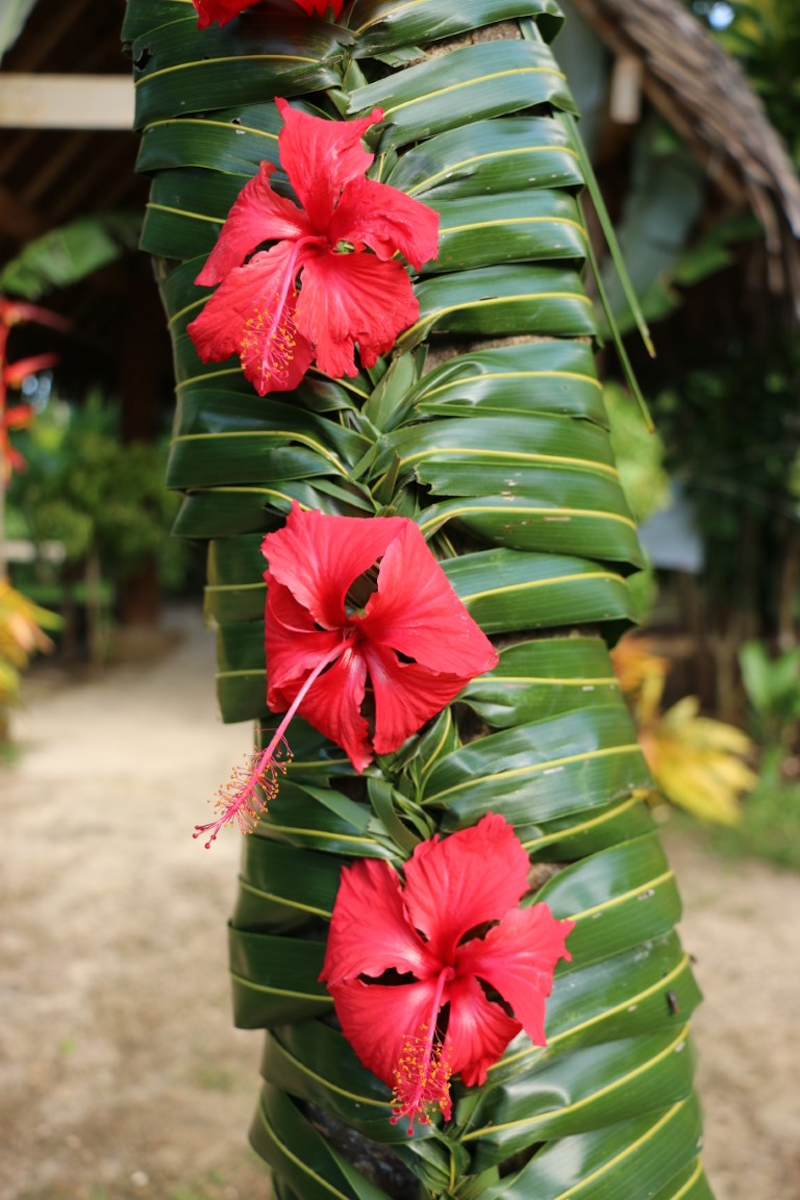 |
These boys showed how kava is prepared. The older boy chopped up the kava root into pieces with a stone tool.
When that was done, he squeezed the pulp into coconut cups and the younger boy diluted this and offered cups of the mildly narcotic liquid to some of the guests.
Kava is traditionally drunk before communal meetings, it is said to ease tension and argument and facilitate peaceful discussion.
It is also widely drunk by the general population in social settings.
|
 |
Women and girls gave a presentation of traditional dances, inviting some of the guests to join them.
|
 |
|
Men and boys then presented their dances, often depicting fighting and hunting.
|
 |
Probably the highlight of the cultural displays of the day was the Vanuatu Water Music performance.
This originated in the northern Vanuatu islands of Gaua and Mere Lava.
In the half full swimming pool, the women beat and slap the water, lean over and move it towards their bodies in ways which produce extraordinary sounds and beats.
Chanting and guitar playing accompanies the water music.
It is impossible to describe these sounds and rhythms without experiencing it, it was truly awesome to hear!
|
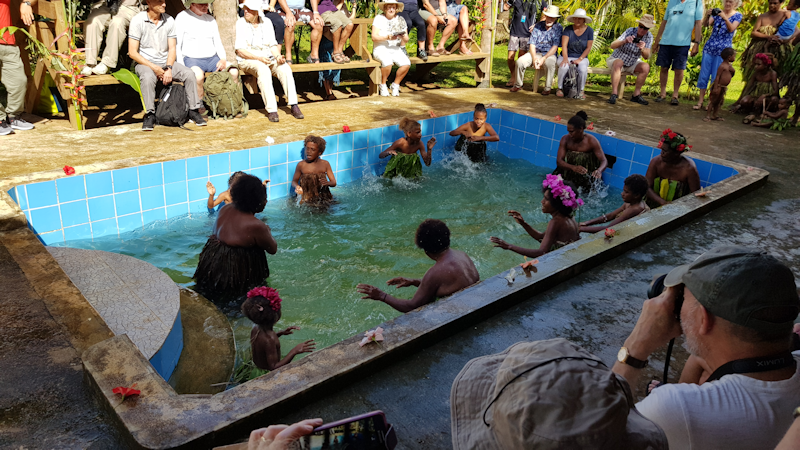 |
|
These three females took part in the women's dancing. The toddler was especially appreciated by the guests for her contribution to the entertainment.
|
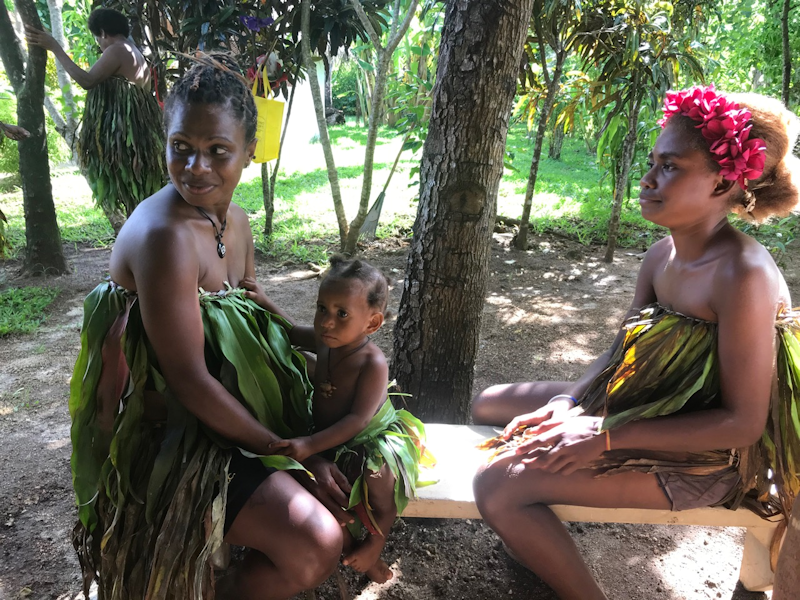 |
The Riri Blue Hole is a natural swimming lake filled by a freshwater spring emerging through limestone.
The pool is surrounded by tropical jungle and there is a rope swing to enjoy and good way to recreate moments in your youth!
|
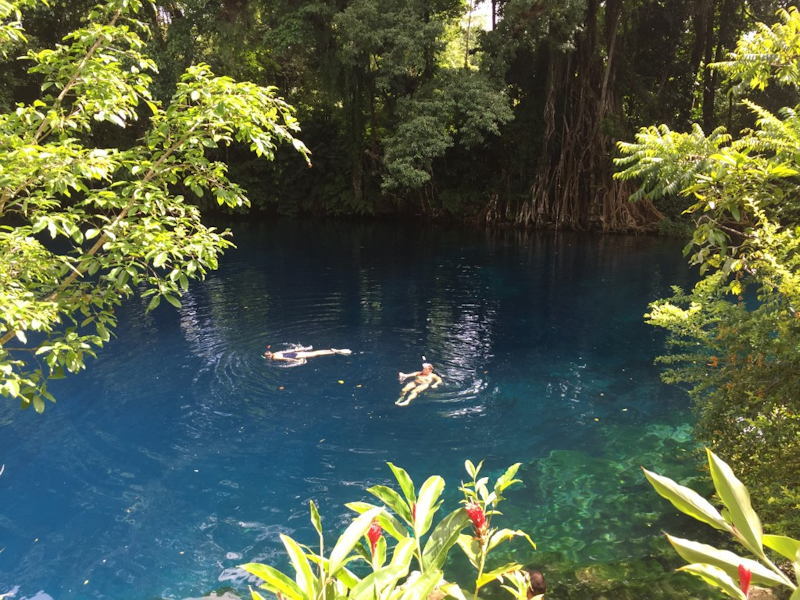 |
|
Another view showing the rich blues and turquoises of the limestone-filtered water.
|
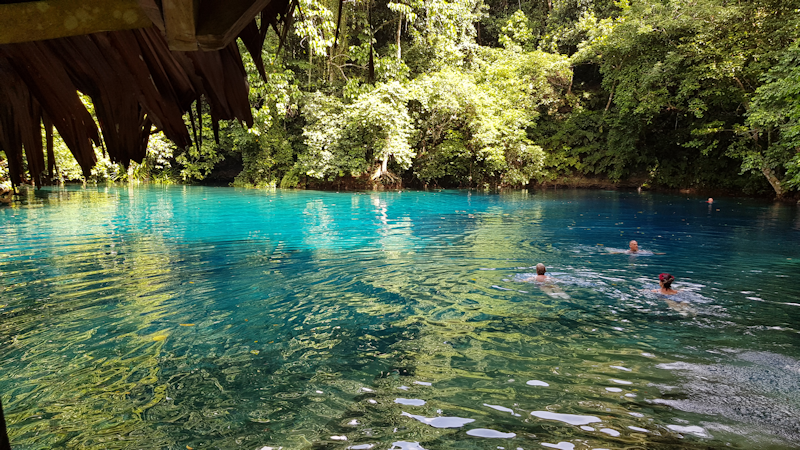 |
|
Here I am contemplating life on a submerged tree bough. |
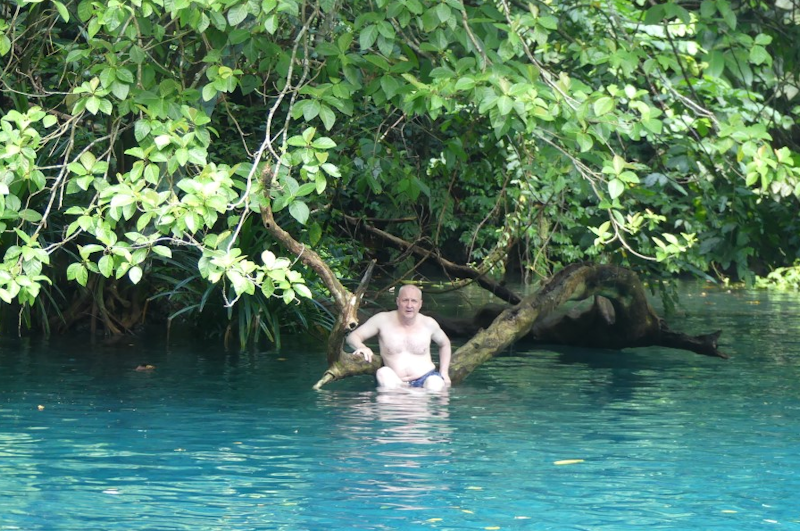 |
After lunch back on the ship, minibuses again transported us out of town.
This was Million Dollar Point, an area of sea where the US military dumped large quantities of stores, equipment and vehicles into the sea.
This was deemed to be the best solution to dispose of all the stuff, given that the local communities didn't wish to accept the materiel for their own use.
|
 |
Here at the Point, there happened to be a stiff breeze and an onshore current.
I was ill-prepared for my snorkelling session, not bringing reef shoes or flippers.
While being pushed by the waves towards the shore with bits of rusty metal and blocks of coral in the shallows, I put my foot down onto something sharp and cut the skin on my ankle.
This was to severely limit my holiday activities in the next few days, especially swimming and snorkelling.
|
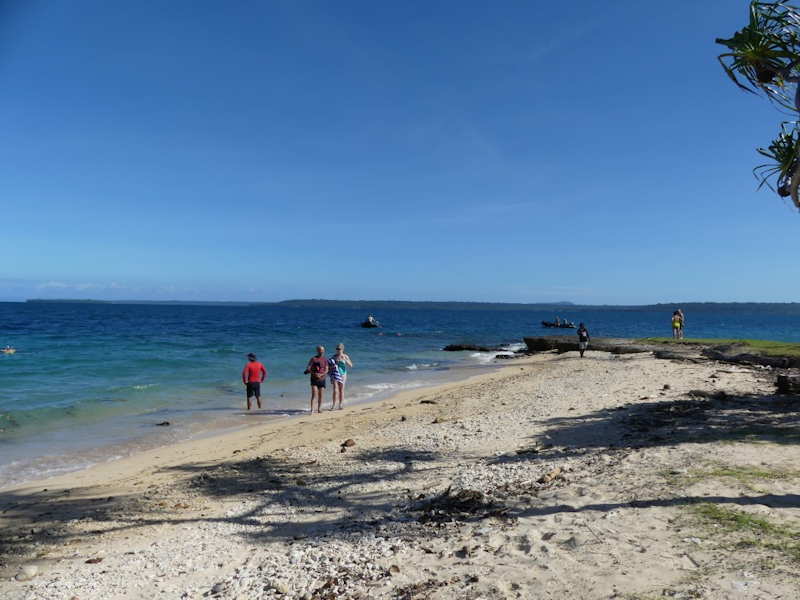 |
|
Here is what I could have seen if I'd been able to get further away from the shore.
|
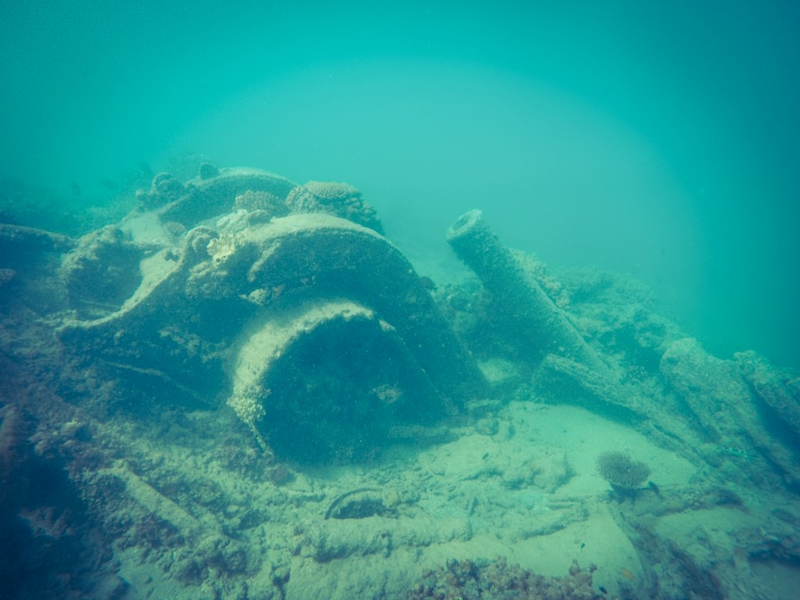 |
|
Oh well, no more swimmimg for a while, so I'll enjoy a bottle of the local Tusker beer, brewed at Port Vila.
|
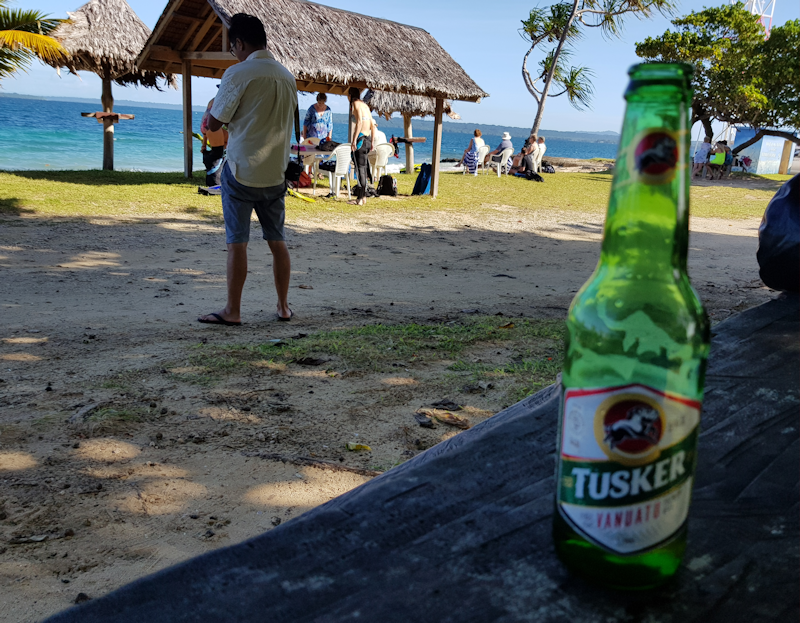 |
Tuesday 14th May.
Rah Island, our fifth and last day in Vanuatu.
Given I had my sore ankle, I stayed on board all day, so many of the pictures on this page were provided by the Expedition crew.
The Banks Islands were mapped by Captain Bligh (of mutiny fame) in 1793, and named after the naturalist, Sir Joseph Banks.
Gaua is the largest of the Banks Islands, at 132 square miles, with a peak at Mount Garet (2615 feet), an active volcano.
Vanua Lava is the next largest. Rah island is a small coral islet situated very close to the large Motalava island.
|
 |
In the morning we sail north towards today's stop at Rah.
The large island in this photo is Vanua Lava, about 15 miles by 12 miles.
It has an airstrip and an active volcano - Sere Ama, at 921m.
|
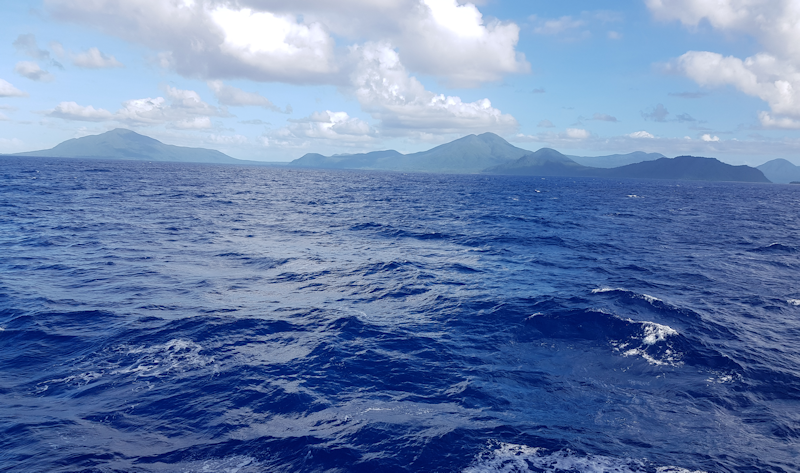 |
|
This is Rah Island, looking east from the ship.
|
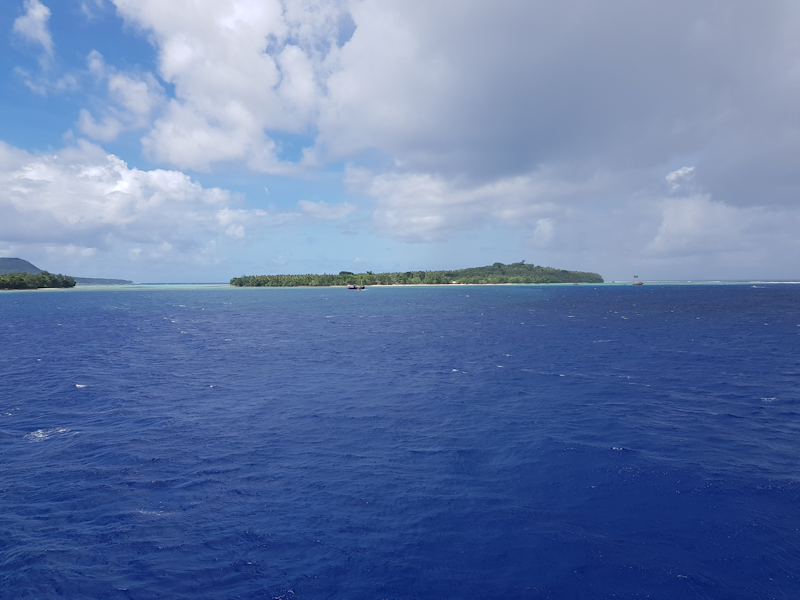 |
|
The islanders welcome the touring party on the sea shore with music and song.
|
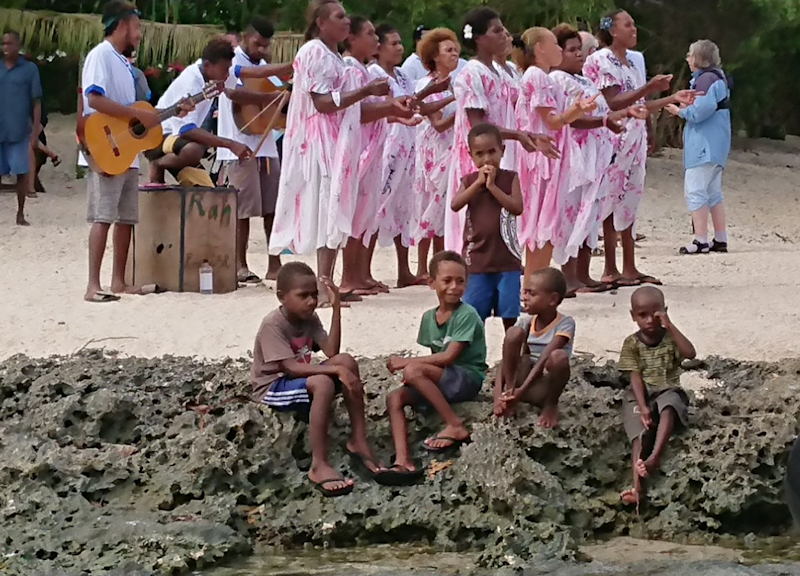 |
|
A corner of the village and some residents.
|
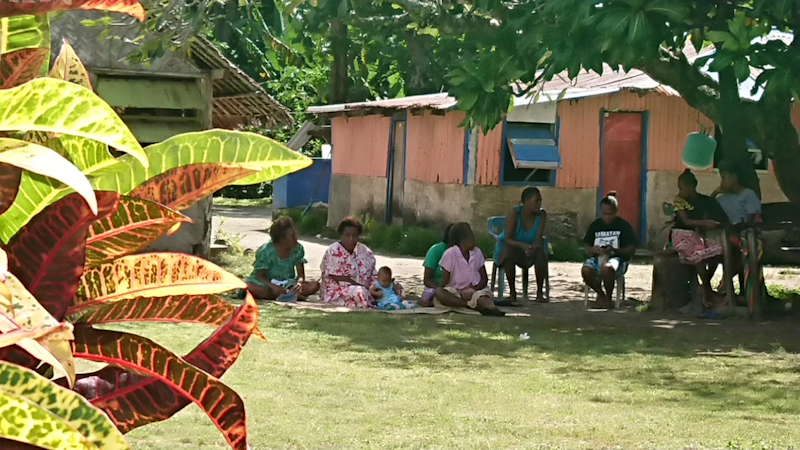 |
The local men who performed the famous Rah Snake Dance, who paint themselves to resemble black and white sea snakes.
I wasn't able to see the dance, of course, but it was obvious from the photos taken that it was popular with the guests.
|
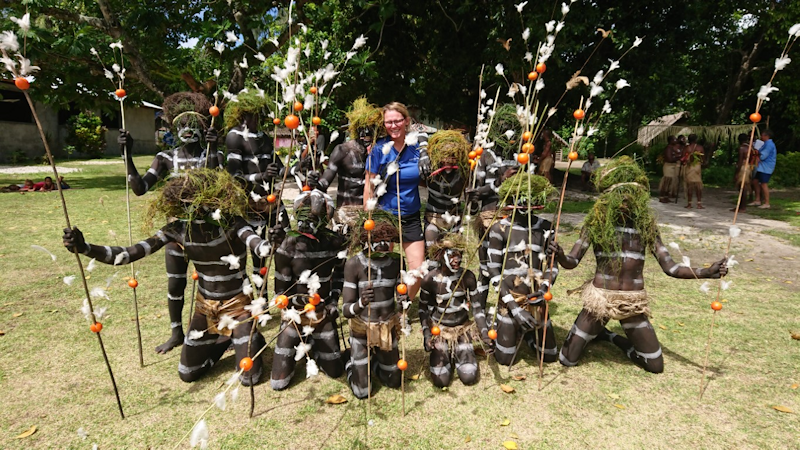 |
|
Some of the guests take part in dancing with both the men and women's groups.
|
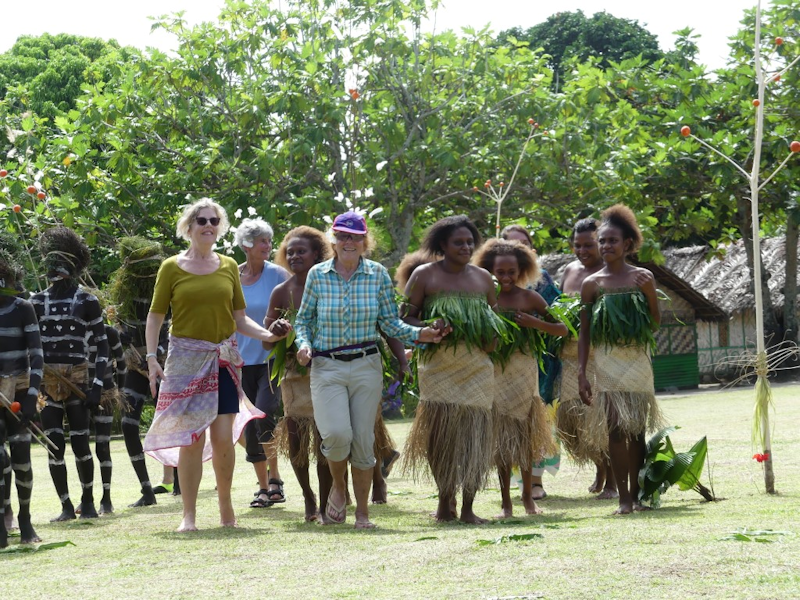 |
|
A fond farewell from the local villagers as the passengers leave Rah Island and return to the ship for lunch.
|
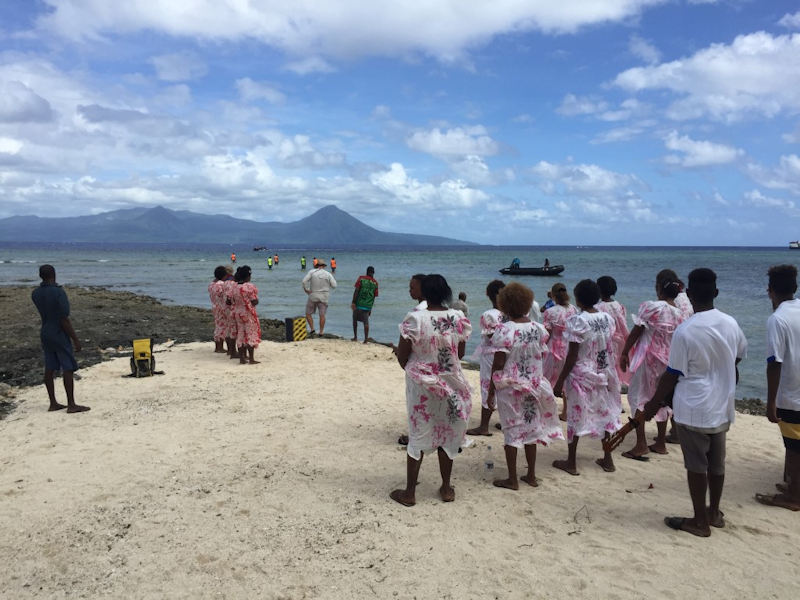 |
Sometimes the swell or rough sea conditions meant that zodiacs had to be roped to the rear access deck and passengers had to slide down into the boat or be manhandled up and off the boat by the crew.
Safety was always a priority and there were techniques that all passengers and crew followed during embarkation and disembarkation.
|
 |
In the afternoon some passengers opted to go snorkelling in the open sea, using zodiacs as platforms.
The distinctive little islet with the two coconut trees was close to the snorkelling area.
|
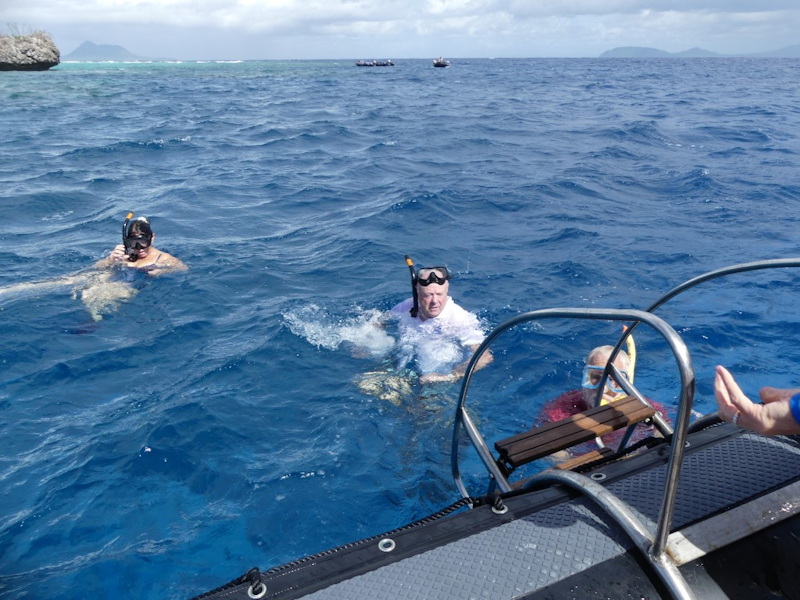 |
|
Here's that little islet within the reef near Rah Island.
|
 |
In the early evening the ship left Rah Island and headed north towards the last of the larger Banks Islands, the island of Ureparapara, a volcanic cone which over time has been eroded by the sea to create a large bay in its centre.
We entered this bay and celebrated with cocktails and horse's doofers on the upper deck to say farewell to Vanuatu.
|
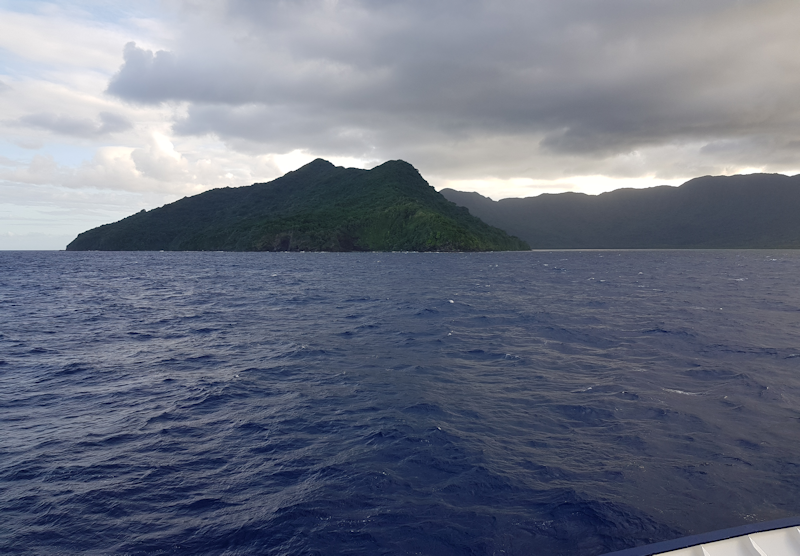 |
Here we are, probably all 73 of the passengers and most of the Expeditionary crew in this group photo taken within the flooded caldera of Ureparapara.
While we were there a number of dugout canoes containing local boys and men which came out to greet us, I imagine they would very rarely have a cruise ship enter their bay.
|
 |






































































